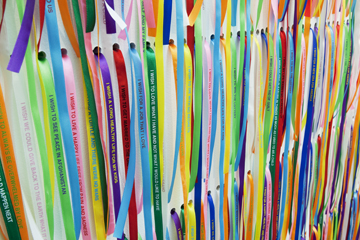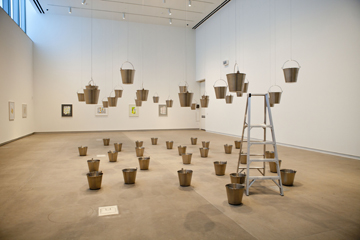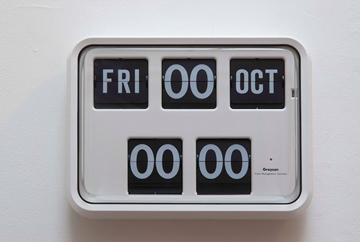
Detail from "I Wish Your Wish," 2003. Installation view from "Rivane Neuenschwander: A Day Like Any Other," New Museum, New York, 2010. Silkscreen on fabric ribbons, dimensions variable. Photo by Benoit Pailley.
Earlier this week, art historian Monica Amor lectured at the Mildred Lane Kemper Art Museum at Washington University in St. Louis on the topic of Neo-Concrete art in Brazil in the late 1950s and 1960s. This talk was presented in coordination with the mid-career survey of work by contemporary Brazilian artist Rivane Neuenschwander, organized by the New Museum in New York and currently on view at the Kemper. Amor’s lecture focused specifically on the work of Lygia Clark and Hélio Oiticica and offered insight into the rich artistic legacy of Brazilian conceptualism, a legacy that Neuenschwander shares. During the Q&A, the question of influence was raised when an audience member asked whether a direct relationship existed between this earlier work and that of Neuenschwander’s contemporary practice in Brazil. Many critics have attempted to anchor Neuenschwander’s work in a historical trajectory that begins with the Brazilian Neo-Concrete tradition and its emphasis on participatory actions, sensory experience, and contingency. Indeed, the artist’s use of simple, often unorthodox materials and the way in which she opens the work of art up to forces of nature and outside participants, be they ants, snails, or visitors, is readily linked to the practices of Clark and Oiticica. Her work with installation and participation also resonates strongly with broader international trends in contemporary art from the 1960s until today.
In her answer to this question, Amor made the point that Neo-Concretism in Brazil can be understood in much the same way that Minimalism functions in the United States: as a foundational art movement that established a critical legacy of experimentation. Neo-Concretism advanced radically new concepts about what art is by expanding the parameters for the relationship between artist, artwork, and viewer, and is undoubtedly an important precedent for Neuenschwander. This kind of historical similitude based on artistic lineage is just one of the ways in which we might address the question of influence in Neuenschwander’s creative practice.

Installation view from "Rivane Neuenschwander: A Day Like Any Other" at the Mildred Lane Kemper Art Museum, Washington University in St. Louis, 2010. Foreground: "Rain Rains," 2002. Courtesy the artist; Tonya Bonakdar Gallery, New York; Galeria Fortes Vilaça, São Paulo; and Stephen Friedman Gallery, London. Photo by Whitney Curtis.
The outside world, particularly everyday life in Brazil, provides an indefatigable source of inspiration for the artist in terms of subject matter and motif. Neuenschwander works across a range of media and engages with a multitude of themes, including nature, language, temporality, and the quiet poetry of daily rituals. She also frequently complicates her own authorship by incorporating chance and outside participation as means of blurring the distinction between creator and viewer. So influence works on a variety of levels here: cultural, environmental, and through the participation of other people.
Let’s take one of Neuenschwander’s signature pieces, Rain Rains (Chove chuva) (2002), for example. The inspiration for this piece derives from both the natural environment of Brazil and its popular musical traditions. A series of buckets is suspended from the ceiling of the gallery, each holding water that drips through a small hole into a corresponding bucket beneath, creating artificial rain. Brazil endures an intense annual rainy season and buckets such as these are a common sight; the rhythmic drips and drops of rainwater through a roof are part of everyday life. The title of this piece refers to two well-known pop songs from Brazil: Chove lá Fora (It’s Raining Outside), a sorrow-filled bossa nova song produced in 1958 by Tito Madi, and Chove Chuva (Constant Rain), a 1963 song by Jorge Benjor that also expresses a strong feeling of melancholy. In order for the piece to truly function, it requires activation. Every four hours, the collected water must be placed back into the upper buckets by a museum attendant in order to maintain the system of circulation.
In I Wish Your Wish (2003), another of Neuenschwander’s signature participatory installations, activation by an outside source is similarly required. Rather than turning to the natural environment for inspiration, focus is placed on Brazilian folk tradition. The installation consists of thousands of colored ribbons of the type that pilgrims tie to the iron fence at the church of Nosso Senhor do Bonfim in Salvador Bahia in the belief that when the ribbons fall off, their wishes will be granted. Rather than typical inscriptions of remembrance, the artist has the ribbons printed with wishes by anonymous people. Visitors are invited to take a ribbon and tie it around one’s wrist so that, over time, the ribbon will fall off and the wish will come true. Participants are asked to replace their chosen wish with one of their own by writing it down on a piece of paper and placing into a vacant hole in the wall. The cycle of exchange exhibited in the recycling of water in the buckets is substituted in this instance with the sharing of private hopes.
One of Neuenschwander’s latest bodies of work, a series of intimately scaled paintings titled At a Certain Distance (Ex-Voto Paintings) (2010), resonates clearly with I Wish Your Wish. These jewel-like works are inspired by Latin American ex-voto paintings—commissioned images most often painted on tin or wood panel and dedicated to a saint to commemorate an event or in hope of a wish being fulfilled. Traditional ex-votos tell a story through narrative iconography and are accompanied by captions that clarify the account. In her paintings, Neuenschwander removes all the text and figures, leaving geometric abstractions that highlight the formal architectural properties and decorative patterns that ground these compositions. It is up to the viewer to project their own stories and wishes into these evacuated spaces.

Rivane Neuenschwander, "A Day Like Any Other," 2008. Modified flip clocks, dimensions variable. Courtesy the Inhotim Collection, Minas Gerais, Brazil.
The strong emotional, often somatic aspect in much of Neuenschwander’s work derives in large part from the artist’s continued fascination with the precariousness of time. While hope and expectation are present in works such as I Wish Your Wish and the ex-voto paintings, Neuenschwander plays on the fact that these feelings are often interwoven with anxiety about what the future might hold. In A Day Like Any Other (2008), the piece from which her current exhibition takes its name, time is literally frozen. The work consists of twenty-four modified flip clocks placed inside the museum galleries and in public locations where one might expect to find a functioning clock. While these clocks advance, they lead nowhere for all of their numbers have been replaced by zeroes. For some, this state of suspension is perceived as a peaceful one; we are no longer racing against the clock. For others, this halting of time’s progression produces nervousness and a heightened awareness of time ticking away whenever another zero flips. Taken together, these pieces exemplify the artist’s fundamental preoccupation with the duality of everyday life — repetitive yet subject to change at any moment — and the influence of both the universal and profoundly personal.
Meredith Malone is Associate Curator at the Mildred Lane Kemper Art Museum, on the campus of Washington University in St. Louis.



Pingback: Society of Contemporary Art Historians | Neuenschwander and Influence